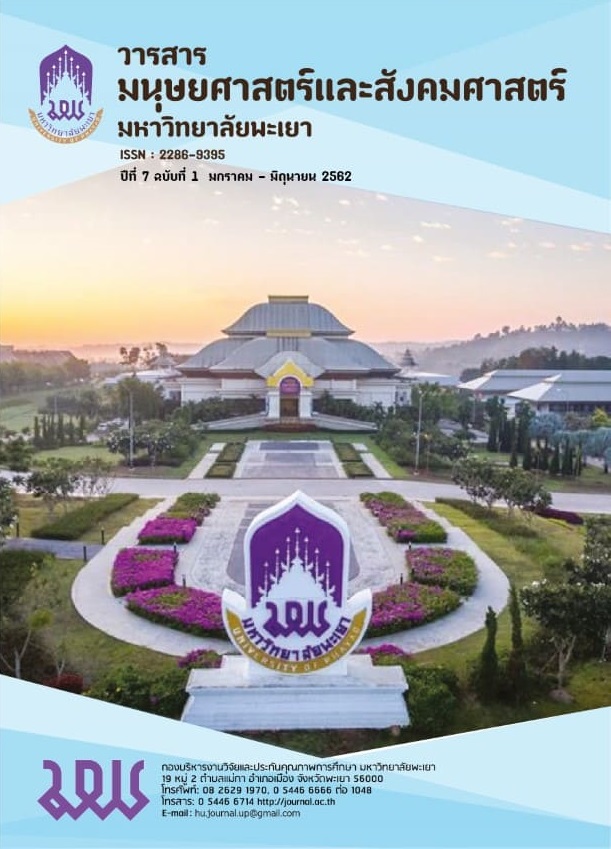Lhong Fai : A Character Analysis using Abraham Maslow's Hierarchical Theory of Motivation
Keywords:
Lhong Fai, Hierarchical Theory of Motivation, Abraham MaslowAbstract
This research aimed to analyze the behavior of the protagonists in Lhong Fai novel, according to the motivational theory of Abraham Maslow’s hierarchy. The data was collected by using qualitative research methodology and the results were presented by using descriptive analysis. The findings found that six major characters are Kankeaw, Chara, Chon, Kunchorn, Awut and Kiew. There was in the following a hierarchy of requirements. Step 1 Physiological needs, they were to live a life to survive. Step 2 Safety needs , there were only Chon, Kankeaw, Chara, Kunchorn, and Awut. Step 3 Belongingness and love needs, there were only Chon, Kankeaw, Chara, Awut and Kunchorn because they used their love as tools to meet their needs. In Step 4, Esteem needs from oneself and other and step 5 Self actualized needs, It was a hierarchy of needs according to the driving force of each person. It could be seen that the needs of the characters were expressed in the order. It was found that the demand went to a higher level. The characters met with disappointment when their demands were down. According to the results, they showed the instinct to survive and respond to human needs through the behavior of the characters. It also gave an insight into the behavior of human beings.
References
กฤษณา อโศกสิน. (2554). หลงไฟ. พิมพ์ครั้งที่ 4. กรุงเทพฯ : เพื่อนดี.
จิราภา เต็งไตรรัตน์ และคณะ. (2556). จิตวิทยาทั่วไป. พิมพ์ครั้งที่ 7. กรุงเทพฯ : มหาวิทยาลัยธรรมศาสตร์.
ปรียาพร วงศ์อนุตรโรจน์. (2551). จิตวิทยาอุตสาหกรรม. กรุงเทพฯ : พิมพ์ดี.
พรจันทร์ เสียงสอน. (2557). การนำเสนอผู้หญิงและความรุนแรงในภาพยนตร์ไทย. วารสารนิด้าภาษาและการสื่อสาร, 19(23), 12-37.
ยุวดี เนื่องโนราช. (2558). จิตวิทยาพื้นฐาน. กรุงเทพฯ : โอเอสพริ้นติ้งเฮ้าส์.
ศรีเรือน แก้วกังวาน. (2561). ทฤษฎีจิตวิทยาบุคลิกภาพ. พิมพ์ครั้งที่ 17. กรุงเทพฯ : หมอชาวบ้าน.
สมปราชญ์ วุฒิจันทร์. (2549). วิเคราะห์นวนิยายของนักเขียนสตรีไทยที่มีตัวละครเอกเป็นโสเภณี. วิทยานิพนธ์ศิลปศาสตรมหาบัณฑิต มหาวิทยาลัยสงขลานครินทร์ วิทยาเขตปัตตานี.
อุไรวรรณ สิงห์ทอง และคณะ. (2561). การวิเคราะห์พฤติกรรมด้านมืดของตัวละครที่ปรากฏในนวนิยาย เรื่อง บ่วงหงส์ ของกิ่งฉัตร. รายงานสืบเนื่องจากการประชุมวิชาการ (PROCEEDING) ระดับชาติและนานาชาติ ครั้งที่ 2 มหาวิทยาลัยราชภัฏบุรีรัมย์, 1028-1037.
Downloads
Published
How to Cite
Issue
Section
License
ผู้นิพนธ์ต้องรับผิดชอบข้อความในบทนิพนธ์ของตน มหาวิทยาลัยพะเยาไม่จำเป็นต้องเห็นด้วยกับบทความที่ตีพิมพ์เสมอไป ผู้สนใจสามารถคัดลอก และนำไปใช้ได้ แต่จะต้องขออนุมัติเจ้าของ และได้รับการอนุมัติเป็นลายลักษณ์อักษรก่อน พร้อมกับมีการอ้างอิงและกล่าวคำขอบคุณให้ถูกต้องด้วย
The authors are themselves responsible for their contents. Signed articles may not always reflect the opinion of University of Phayao. The articles can be reproduced and reprinted, provided that permission is given by the authors and acknowledgement must be given.







